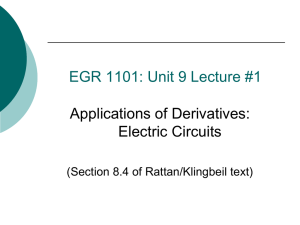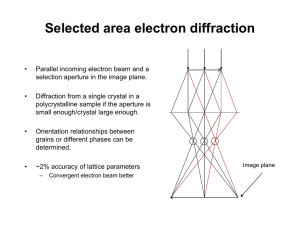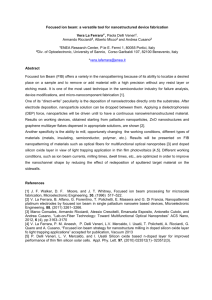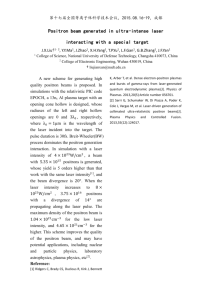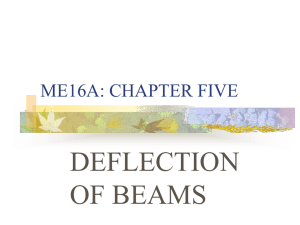PFC/JA-93-15 C. Linear and Nonlinear Analysis of the
advertisement
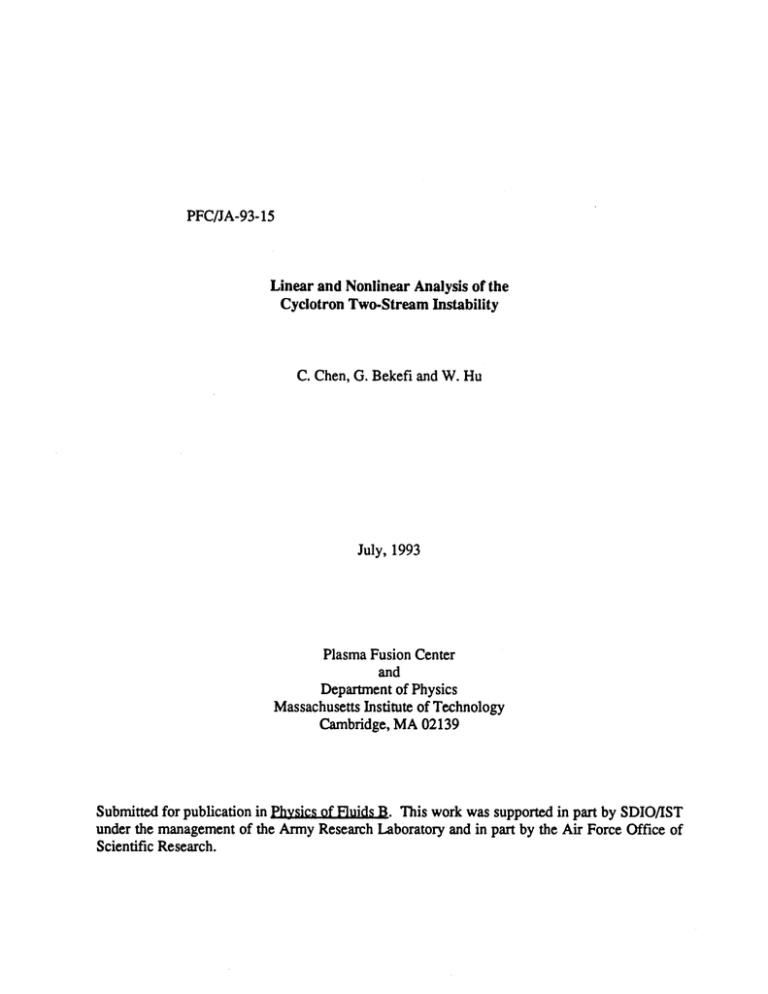
PFC/JA-93-15
Linear and Nonlinear Analysis of the
Cyclotron Two-Stream Instability
C. Chen, G. Bekefi and W. Hu
July, 1993
Plasma Fusion Center
and
Department of Physics
Massachusetts Institute of Technology
Cambridge, MA 02139
Submitted for publication in Physics of Fluids B. This work was supported in part by SDIO/IST
under the management of the Army Research Laboratory and in part by the Air Force Office of
Scientific Research.
Linear and Nonlinear Analysis of the Cyclotron Two-Stream Instability
Chiping Chen, George Bekefi, and Wen Hu
Plasma Fusion Center,
Research Laboratory of Electronics, and
Department of Physics
Massachusetts Institute of Technology
Cambridge, Massachusetts 02139
ABSTRACT
A two-dimensional, self-consistent, nonlinear model is used to determine the growth
rate and saturation level of the cyclotron two-stream instability for two weakly relativistic
electron beams co-propagating along a uniform magnetic field with an inverted population
in the perpendicular momentum. This instability has been proposed recently as the basis
for a double-stream cyclotron maser. Good agreement is found between the dispersion
analysis and computer simulations in the linear regime. The effect of axial momentum
spread on the instability is investigated.
It is shown that the cyclotron two-stream
instability is primarily electrostatic, which calls for further exploration of an effective
input and output coupling scheme for the maser.
PACS numbers: 41.60.Cr, 41.75.Ht, 52.75.Ms, 52.25.Wz
1
I. INTRODUCTION
The exploration of novel mechanisms of generating millimeter waves with relativistic
electron beams has been pursued vigorously in recent years. The sought-after operating
regime of millimeter wave sources of particular interest would require a mildly relativistic
(
100 kV) electron beam and moderate magnetic field (
1 kG). The double-stream
cyclotron maser [1], which utilizes two mildly relativistic electrop beams co-propagating
along an applied uniform magnetic field with an inverted population in the perpendicular
momentum, is one of the proposed mechanisms that satisfies this requirement.
The operating principle of the double-stream cyclotron maser [1] is based on the unstable interaction of the fast cyclotron space-charge wave on one electron beam and the
slow cyclotron space-charge wave on the other electron beam. Such an unstable interaction, which we refer to as the cyclotron two-stream instability, leads to the stimulated
bunching of the gyrophases of the electrons relative to the wave phase. The cyclotron
two-stream instability belongs to the class of multiple species, quasi-electrostatic streaming instabilities well known in plasma physics. Figure 1 shows a schematic dispersion
diagram for such a two-stream system, where there are an infinite number of unstable
regions appearing in the vicinities of the intersections of the cyclotron modes of one beam
with those of the other beam. Because the resonant frequency of the cyclotron two-stream
interaction is proportional to the cyclotron frequency and is inversely proportional to the
difference in the axial velocities of the beams, the double-stream cyclotron maser can operate at high frequencies without the need of either high beam voltage or high magnetic
field.
In this paper, we present a two-dimensional, self-consistent, fully nonlinear waveparticle model for studies of the feasibility of the double-stream cyclotron maser in particular and the cyclotron two-stream instability in general. The linear and nonlinear coupling of axisymmetric cyclotron space-charge waves on two weakly relativistic electron
2
beams co-propagating in a uniform magnetic field is investigated in cylindrical geometry. When the Doppler shift in frequency is much greater than the cyclotron frequency,
the coupling is shown to be primarily electrostatic, which differs qualitatively from an
electromagnetic type of coupling considered previously [2]. The linearized equations of
motion in the present wave-particle model are used to derive a dispersion relation for
the electrostatic coupling, which is in agreement with what was derived previously [3]
using kinetic theory. The linear stability properties are analyzed. It is found that, like
the conventional cyclotron autoresonance maser (CARM) [4],[5], the instability growth
rate decreases rapidly with increasing axial velocity spread (i.e., axial beam temperature) within each electron beam. Good agreement is found between the stability analysis
and computer simulations in the linear regime. The saturation level of the instability is
obtained from simulations for parameter regimes of experimental interest.
The cyclotron two-stream instability is also expected to occur in space plasmas where
electrons and ions may stream along a magnetic field with an inverted population in
the perpendicular momentum. The model presented in this paper can be generalized
to describe the dynamical processes involving such electrons and ions. However, this is
beyond the scope of the present paper.
II. THE MATHEMATICAL FORMULATION
We consider two concentric annular beams of electrons gyrating, and co-propagating
axially, in an applied uniform magnetic field Boe (Fig. 2). The axes of the beam annuli
coincide with that of a perfectly conducting, cylindrical waveguide through which the
electron beams propagate. Assuming the equilibrium self-electric and self-magnetic fields
of the beams to be negligibly small, we describe the unperturbed beams by the following
equilibrium distribution function
fo(X,p")=
z foa(X,p~)=
a=1,2
E
a=1,2
3
ela
G.(r,)F.(pipz),
(1)
with 27rf G,(r,)rgdr, = 1 and 2rf F,(p, p2 )pdpdp, = 1. In Eq. (1), -e is the electron
charge, p. and p± = (p2 + p2)1/ 2 are the electron axial and perpendicular momentum
components, respectively, r. is the electron guiding-center radius, and I, and V, =
f v 2 Fad~p are the current and average axial velocity of beam a, respectively. Note that
the variables r,, p., and pi are the constants of the unperturbed single electron motion
in the uniform magnetic field Boe, and therefore, the equilibrium distribution function
fo solves for the zeroth-order Vlasov equation.
To derive a complete set of ordinary differential equations describing the self-consistent,
slowly varying, axial evolution of cyclotron space-charge waves in a single-frequency,
stationary-state, double-stream cyclotron maser amplifier, we express the axisymmetric
wave fields in terms of a vector potential of the form
A(r, z, t) = A-(r, z, t)
2 ,
(2)
where the axial component of the vector potential is defined by
A,(r, z, t) =
-
E A,(z)C±. Jo(kL,,r) exp{i[0 k,,(z')dz' - wt]} + c.c
(3)
and the transverse components A,.(r, z, t) and AO(r, z, t) are ignored. The electric and
magnetic field perturbations are then uniquely determined from Eq. (3) using the Lorentz
gauge condition. In the regime considered in the present analysis, the neglect of the
transverse components of the vector potential is justified because the coupling is primarily
through electrostatic forces due to a large Doppler upshift of the cyclotron frequency.
In Eq. (3), the index n designates a TMOn type of transverse-magnetic mode, and
Jo(x) is the zeroth-order Bessel function of the first kind. The transverse field profile
Jo(k±,nr) corresponds to that of the vacuum TMOn mode, provided that the boundary
condition Jo(kL,,b) = 0 is satisfied. Here, b is the waveguide radius, k 1 ,, = p,/b, p, is
the n-th zero of Jo(x), and
CjLn = 70/ 2 p,,J_(,,
4
(4)
is a normalization constant. In the present model, the coupling between the wave fields
and the beam density and current perturbations is described by the slowly varying wave
amplitudes A,(z) and the slowly varying axial wave numbers k2,(z). It should be noted
that the axisymmetric vector potential in Eq. (3) is expressed as a superposition of a
complete set of the vacuum TMOn modes and thereby allows us to treat both electrostatic waves and electromagnetic waves on the same footing. Detailed discussions of this
expansion technique can be found in references [6] and [7].
From the Lorentz and Maxwell equations, it can be shown that a complete set of
normalized ordinary differential equations governing the double-stream cyclotron maser
amplifier is given approximately by
dpni
di
d~ 00
=
X.1rr 2
(1 - Zk)an +
-
2()
2 an]
1
_
_L
y
P
In
+ -
(5)
,:p
CsS nO+
dkzn
an + 2k 2 n
dan\
sin On,
const ,
(6)
(7)
and
2
C12a,
j2+(i-k-k2.)an+i
da
2
2k
n
00
= i E E gn.(Xnl exp (-il))
d=-oo a=1,2
+a
. (8)
The procedure of deriving Eqs. (5)-(8) can be found in [6].
Equations (5)-(7) describe the dynamics of an individual beam electron. In our simulations, we solve numerically 6N of such equations of motion for N macroparticles
representing the electrons of each beam, where N = 1024 is typical. The phase O, is
defined by
Oni(z, 0, 9, t) =
j
k 2n(z')dz' - wt + l tan-'(py/p.) - l9g + 17r/2
(9)
and represents the l-th harmonic gyrophase of the electron relative to the phase of the
n-th mode, where Og
const is the polar angle of the guiding center of the electron.
5
X,,(r,,rL) = J,(kfL.r,)J(kflrL) is a geometric factor and rL is the Larmor radius of the
wz/c, k2,
electron. The normalization is such that i =
pZ/mc,
ne = fl/w = eBo/mcw,
= ck,,/w, P-j = pj/mc, P, =
etc., (which is equivalent to setting m = e = c = w = 1,
where m is the electron rest mass, and c, the speed of light in vacuum).
Equation (8) describes the self-consistent evolution of both the normalized wave amplitude a,(i) and axial wave number k,,(i). The dimensionless coupling constant in
Eq. (8) is defined by
gna = 87r (
kL
CL)(o(10)
W
kJin
IA
where IA = mc 3 /e = 17 kA is proportional to the Alfv6n current. The notation (X),
=
N- 1 J=j X1 denotes the ensemble average over the particle distribution of beam a.
The average electromagnetic power flow (i.e., Poynting flux) through the waveguide
cross section at the axial distance z is given by
00
P(z) = ZPn(z) ,
n=1
(11)
where
P.(z) =
87r
ckn(Z)
w
ck i
'(
)'a2(z)
C1
(12)
is the power contributed by the n-th mode and Po = m 2 c5 /e 2 = 8.7 GW. Moreover, the
average rf e-beam power flow is given by
P6 = a
a=1,2
Po
(
IA
))
(13)
From Eqs. (6), (8), and (10)-(13), it follows that the total rf power is conserved, i.e.,
P(z) + Pb(z) = const.
The mathematical formulation presented above is readily used to examine the stability properties and saturation levels of cyclotron space-charge waves on two relativistic
electron beams co-propagating in a finite magnetic field. In principle, the present formulation is also applicable in regimes where the gyromotion of the beam electrons is
6
negligible, (i.e., B0 -+ oo), as in the two-stream relativistic klystron amplifier [8],[9] configuration. The latter case is obtained by setting the cyclotron harmonic number l equal
to zero for each beam. In the remainder of this paper, we present results of a single-mode
analysis in which we let n be a single integer but allow the cyclotron harmonic number
I to assume integers 0, ±1, i2,.. ..
III. ELECTROSTATIC DISPERSION RELATION
In the small-signal regime, we can linearize Eqs. (5)-(8) and derive a dispersion relation. Making an electrostatic approximation (k2 + k2 > w2 /c 2 ), and choosing the
equilibrium distribution function in Eq. (1) with
1
6(r,
G.(r,) =
(14)
- r,,)
and
F.(p±,p 2 ) =
1
27rpL,
8(p± - P±1 ) 6 (p. - P.')
(15)
,
it is readily shown that the dispersion relation for the n-th mode can be expressed as
Z Z
DL(w,k)=l-
2
Eac2 k
(w - k~v2,, - 1~/a
1=oa,=1,2
In Eq. (16), we have neglected terms of order (w - k2 v2 , -l~/,)-
= 0.
1.
(16)
Neglect of this term
is well justified whenever k±/k, < 1, as is the case of present interest. The normalized
coupling constant is defined by
4
#_T, 7
"
(Ic ' J (klnrc)Jl(klnrrt)
ka bJ6(k.n b)
'\I l
which is related to gn,, defined in Eq. (10). Here, y = (1 +
=1, $±./-.,
-
= (1
-
Il.2)-1/2,
rTL
pi2
2
'
+ pI") 1/2_
= paL/mlc is the electron Larmor radius of
beam ce, and JI(x) is the first-kind Bessel function of order 1. The electrostatic dispersion
relation (16) has been derived previously
[3]
7
in cylindrical geometry using kinetic theory
in the context of a coherently gyrophased electron beam [3],[10], and it is a generalization
of a previously obtained dispersion relation [11] for an unbounded system.
IV. NUMERICAL ANALYSIS
We have developed a computer simulation code to integrate Eqs. (5)-(8) numerically.
The code has been benchmarked against the linear theory in Sec. III in the small-signal
regime. The results of the benchmark simulations are summarized in Figs. 3-5 for the
choice of system parameters listed in Table I, where the TM0 2 mode is chosen to maximize
the coupling strength.
The (linear) intensity growth rate is plotted in Fig. 3 as a function of frequency.
The solid curve is obtained from the electrostatic dispersion relation (16), and the open
circles are results from the simulations using Eqs. (5)-(8) which are based on the full
Maxwell equation rather than the Poisson equation alone. There are two unstable regions
separated at the resonant frequency f = 34.4 GHz at which the system is stable. The
maximum growth rate is 40 dB/m, which occurs at f = 26 and 40 GHz. The fact that
there is good agreement between the simulations and the dispersion analysis, as shown
in Fig. 3, illustrates that the coupling is indeed primarily electrostatic.
The axial evolution of the normalized wave amplitude is plotted in Fig. 4 for f = 40
GHz. At saturation the ac electromagnetic power flow P 2 (z) is rather low (< 1 kW)
compared with the dc beam power because the wave is primarily electrostatic. Therefore,
in order to assure an efficient operation of the maser, an effective input and output
coupling scheme is to be sought
The phase space of the electrons, (b 26,y), is shown in Fig. 5 at the initial position
z = 0 and the final position z = 200 cm.
In Fig. 5, the open circles represent the
macroparticles in beam 1 and the open squares represent the macroparticles in beam
2. At z = 0, the gyrophases of the macroparticles in both beams are slightly bunched
8
relative to the wave phase so that a small wave amplitude can be assigned initially in
the simulation. At z = 200 cm, the gyrophases of the macroparticles in beam 1 (the
circles) are well bunched at the phase 0 =
02
~ 37r/2, whereas the gyrophases of the
macroparticles in beam 2 (the squares) are well bunched at the phase ;b =
02-1
e
7r/2.
One beam bunching out of phase relative to the other beam is a characteristic of the
unstable two-stream interaction.
Having found good agreement between theory and simulation for a special choice of
the distribution function defined in Eqs. (1), (14), and (15), we have used the code to
examine the sensitivity of the growth rate to axial velocity spread within each electron
beam. In particular, we have loaded the particles in each beam with a Gaussian axial
momentum distribution. The result is shown in Fig. 6, corresponding to the choice of
system parameters used in Fig. 3 at the upper maximum gain frequency f = 40 GHz. The
horizontal axis is a fractional momentum spread defined by ou,/p,
=
pz
/Pzl = Opz2/Pz2,
where oa,2 is the standard width for beam a. It is seen in Fig. 6 that the growth rate
decreases rapidly with increasing spread due to the fact that there is a large Doppler
upshift in the frequency. This sensitivity to axial beam temperature is similar to that in
the cyclotron autoresonance maser (CARM) [4],[5).
V. CONCLUSION AND DISCUSSION
We presented the first self-consistent nonlinear model for studies of the recently proposed double-stream cyclotron maser in particular and the cyclotron two-stream instability in general. The model was used to analyze the linear and nonlinear coupling of the
cyclotron space-charge waves on two weakly relativistic electron beams co-propagating
along a uniform magnetic field with an inverted population in the perpendicular momentum. The growth rate and saturation level of the cyclotron two-stream instability were
determined from small-signal theory and computer simulations for parameter regimes of
9
experimental interest. Good agreement was found between linear theory and simulations
in the small-signal regime. When the Doppler upshift in frequency is much greater than
the cyclotron frequency, the instability growth rate was shown to decrease rapidly with
increasing axial velocity spread within each electron beam.
It was shown that the cyclotron two-stream instability is primarily electrostatic. As
a result, the electromagnetic energy flux through the waveguide cross section was found
to be negligibly small. This calls for further exploration of an efficient input and output
coupling scheme for the double-stream cyclotron maser.
Such a need for identifying
efficient coupling schemes is shared with other slow-wave systems as for example the
relativistic klystron.
The numerical calculations performed in this paper assumed for simplicity two overlapping annular relativistic electron beams. However, the theory presented in Sec. II is
also applicable to annular beams of different radii. When the radii differ, the gain is
reduced, as expected.
ACKNOWLEDGMENTS
This work was supported in part by SDIO/IST under the management of the Army
Research Laboratory and in part by the Air Force Office of Scientific Research.
10
References
[1] G. Bekefi, J. Appl. Phys. 71, 4128 (1992), and references therein.
[2] C. Wang and S. Liu, Int. J. Electron. 57, 1191 (1984).
[3] C. Chen, B.G. Danly, G. Shvets, and J.S. Wurtele, IEEE Trans. Plasma Sci. PS-20,
149 (1992).
[4] V.L. Bratman, N.S. Ginzburg, G.S. Nusinovich, M.I. Petelin, and P.S. Strelkov,
Int. J. Electron. 51, 541 (1981).
[5] G. Bekefi, A.C. DiRienzo, C. Leibovitch, and B.G. Danly, Appl. Phys. Lett. 54, 1302
(1989); A.C. DiRienzo, G. Bekefi, C. Chen, and J.S. Wurtele, Phys. Fluids B3, 1755
(1991).
[6] C. Chen and J.S. Wurtele, Phys. Rev. Lett. 65, 3389 (1990); Phys. Fluids B3, 2133
(1991).
[7] Y.Y. Lau and D. Chernin, Phys. Fluids B4, 3473 (1992).
[8] C. Chen, P. Catravas, and G. Bekefi, Appl. Phys. Lett. 62, 1579 (1993).
[9] H.S. Uhm, Phys. Fluids. B5, in press (1993); H.S. Uhm and C. Chen, submitted to
Phys. Fluids. B (1993).
[10] A. Fruchtman and L. Friedland, IEEE J. Quantum Electron. QE-19, 327 (1983).
[11] A. Bers and C.E. Speck, Massachusetts Institute of Technology, Research Laboratory
of Electronics, Quarterly Progress Report 78, 110 (1965).
11
Table I. Parameters used for the numerical analysis
Resonant frequency
33.4 GHz
Operating mode
TM0 2 (n = 2)
Waveguide radius
Axial magnetic field
2.54 cm
503 G
Beam 1
Current
Voltage
100 A
137 kV
VnL/c
0.2
Guiding-center radius (r,) 1
Harmonic number 1
Coupling constant f121
0.88 cm
1
1.0 x 10-1
Beam 2
Current
Voltage
100 A
163 kV
V12/C
0.2
Guiding-center radius (r,)2
0.88 cm
Harmonic number I
Coupling constant f-122
9.2 x 10-
12
-1
FIGURE CAPTIONS
Fig. I Schematic dispersion diagram for a two-stream system in a finite axial magnetic
field.
Fig. 2 Schematic of a double-stream cyclotron maser. (a) Cross section of the maser
showing the two annular beams and (b) overall view.
Fig. 3 Intensity growth rate as a function bf frequency for the choice of system
parameters listed in Table I. The solid curve from linear theory [Eq. (16)] and the
circles from simulations using Eqs. (5)-(8).
Fig. 4 Normalized wave amplitude as a function of the interaction length z at f = 40
GHz for the choice of system parameters listed in Table I.
Fig. 5 Phase space of the beam electrons at (a) z = 0 and (b) z = 200 cm, corresponding
to Fig. 4.
Fig. 6 (a) Intensity growth rate and (b) saturation wave amplitude as a function of the
fractional axial momentum spread o,,/p2
13
= Oup1/pz1 =
-7pz2/Pz2.
CYi
Ci4 .
N
+~
i
N~
Nr
1N
Nl
It
II
:3
\
N
II\
:3
<
D4
:3
q
Ci1
0
eo
14
(a)
WAVEGUIDE WALL
BEAM 2
ELECTRON
/BEAMS
MAGNETIC
WIGGLER
(b)
BEAM I
ACCELERATOR
SPLIT
CATHODE
ANODE
\SOLENOID
Figure 2
15
WAVEGUIDE
0
LI
0
fn00
(wisp) 31V8 HIMOLS A.LISN3J.NI
16
0
0
ClE
in i
2
0.J
0
oz-
1
0
on
3
17
1
03
10
YON
-I-----II
o-~
0
0
0
0
0
0
0
0
0
0
0
0
0
0
0
0
0
0
0
0
0
0
0
0
0
0
0
0
0
0
0
0
0
0
0
.-
0
o
in
Ir-
lIJ
0
0
0
0
0
0
0
0
0
0
0
0
0
0
0
0
0
0
0
0
0
0
0
0
0
0
0
0
0
0
0
0
0
0
0
0
0
0
0
~0.
0
0
0
0
N~
ftE,
In
if
0
18
N~
In
I
0
ND
---- I-
I I
0
I
0
0
0
0
0
0
0
o
0
0
0
0
0
0
0
0
N
0
0
0
0
0
0
0
LL
0
0
00
0
I
In
0
N
0
0
0
I
0
.
0
8n
P4.
0l
19
U,
I,N
0
~0
N
0
0L
w
0
iMO8
MAP)3MJ
20
AllN31N
